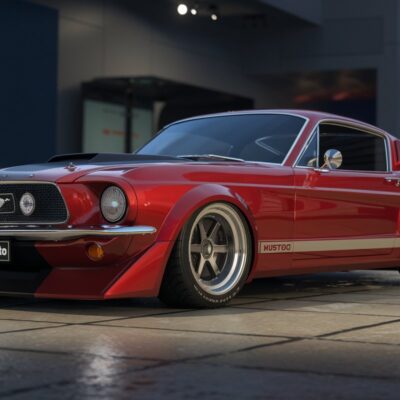The 1949 Mercury stands as a pivotal model in automotive history, marking a significant shift in design and engineering following World War II. This in-depth guide explores every aspect of this influential vehicle, from its groundbreaking design to its lasting impact on car culture.

Key Highlights
- First all-new post-war design from Mercury
- Introduction of the “ponton” or “envelope” body style
- Available as a coupe, sedan, and convertible
- Significant cultural impact and popularity among customizers
- Marked the beginning of Mercury’s rise as a distinct brand
1. Revolutionary Design: The “Ponton” Body Style
1.1 Design Philosophy
The 1949 Mercury introduced the “ponton” or “envelope” body style, a revolutionary approach that emphasized:
- Smooth, flowing lines from front to rear
- Integrated fenders
- A modern, streamlined aesthetic
1.2 Key Design Features
| Feature | Description |
|---|---|
| Profile | Sleek, low-slung silhouette with minimal chrome |
| Grille | Wide, horizontal design with integrated headlights |
| Fenders | Fully integrated into the body, creating a smooth side profile |
| Windshield | Curved, two-piece design for improved visibility |
| Taillights | Distinctive horizontal units integrated into the rear fenders |
1.3 Color Options
The 1949 Mercury was available in a variety of colors, including:
- Dust Gray
- Timberline Green
- Palisade Tan
- Malibu Blue
- Coronado Red
2. Performance and Engineering
2.1 Engine Specifications
| Specification | Details |
|---|---|
| Engine Type | Flathead V8 |
| Displacement | 255 cubic inches (4.2L) |
| Horsepower | 110 hp @ 3,600 rpm |
| Torque | 200 lb-ft @ 2,000 rpm |
| Compression Ratio | 6.8:1 |
| Fuel System | Single two-barrel carburetor |
2.2 Transmission Options
- 3-speed manual (standard)
- 3-speed manual with overdrive (optional)
2.3 Suspension and Chassis
- Front: Independent, coil springs
- Rear: Live axle, leaf springs
- Wheelbase: 118 inches

3. Body Styles and Production Numbers
3.1 Available Body Styles
- Two-door Coupe
- Four-door Sedan
- Convertible
3.2 Production Numbers
| Body Style | Units Produced |
|---|---|
| Coupe | 71,403 |
| Sedan | 218,745 |
| Convertible | 11,111 |
| Total | 301,259 |
4. Interior Features and Options
4.1 Standard Features
- Bench seats with cloth or leather upholstery
- AM radio
- Heater and defroster
- Dashboard clock
4.2 Optional Equipment
- Turn signals
- Fog lights
- White sidewall tires
- Rear fender skirts
- Windshield washer
5. Cultural Impact and Legacy
5.1 In Popular Culture
- Featured in numerous films, including “Rebel Without a Cause” (although a 1949 model was not used in the film, it popularized the Mercury brand)
- Inspiration for custom car culture, particularly the “lead sled” style
- Frequently referenced in hot rod and rockabilly music
5.2 Influence on Custom Car Culture
- Popular platform for customization, especially chopping and lowering
- Iconic status in custom car and hot rod circles
- Inspiration for the “lead sled” style of customization
5.3 Collectibility and Value
| Condition | Estimated Value Range (as of 2024) |
|---|---|
| Concours | $75,000 – $150,000+ |
| Excellent | $50,000 – $100,000 |
| Good | $30,000 – $60,000 |
| Fair | $15,000 – $30,000 |
*Note: Values can vary significantly based on body style, originality, and market conditions.
6. Restoration and Maintenance
6.1 Common Restoration Challenges
- Rust in floor pans, rocker panels, and trunk
- Worn suspension components
- Scarcity of some trim pieces and interior components
6.2 Parts Availability
- Good aftermarket support for mechanical components
- Reproduction parts available for many body and trim pieces
- Original parts can be challenging to find for some unique features
6.3 Maintenance Tips
- Regular oil changes (every 3,000 miles for original engines)
- Periodic chassis lubrication
- Attention to cooling system maintenance
- Proper storage to prevent rust and deterioration

Conclusion
The 1949 Mercury’s combination of revolutionary design, solid performance, and cultural significance solidifies its status as one of the most important American cars of the post-war era. Its enduring popularity among collectors, customizers, and enthusiasts ensures that the ’49 Mercury will continue to be celebrated as a true classic for generations to come.




